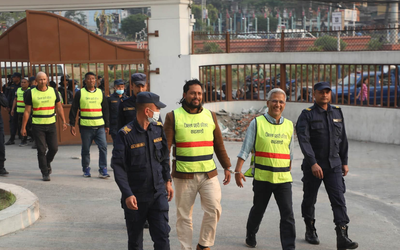More on News





Remittances now contribute around $3.5bn a year to Nepal's annual income, up from just $50m in the mid-1990s, and equivalent to almost a quarter of GDP. In fact, the figure is probably substantially higher as remittances are routinely underestimated; the rule of thumb is to add 40% to the official figures.
The world of development finance that I inhabit touts the rocketing of migrant remittances in the last decade or so as good news, but in reality the motives and impacts of migration are more complex than economists with a penchant for reductionism tend to allow.
Clearly the money remitted (or brought back) by Nepalese migrants who leave for India, the Middle East, Europe and the US can boost the local and national economy, whether it is spent on consumption (food, clothes, enjoyable activities), or invested in homes, education or small businesses.
According to World Bank figures, extreme poverty has declined from almost 70% to 25% in the last 15 years, and the extra billions arriving direct to Nepalese households during this period are undoubtedly part of the story, along with large-scale state investment in social sectors and infrastructure. One young man I spoke to in the mountainous north-west of Nepal had just returned to his village after two years working as a cook for the US army in Afghanistan. He earned $1,500 a month, more than his friends who stayed in the village will earn in a year and more than three times what the local doctor makes.
But many young migrants are excited not only by the prospect of hard cash, but of seeing new parts of the world, even if they know that conditions will be hard and sometimes dangerous. Many also see migration as a chance to escape a life in agriculture, which they see as backward. The cook came back from Afghanistan with a CV that will make further international opportunities eminently possible, transforming not only his family's financial prospects, but also his chances of living a more cosmopolitan life, if that is what he wants.
Meanwhile, the social impacts of such migration are likely to be at least as profound as the financial ones, particularly with regard to family and gender relations. In some Nepalese villages, up to 90% of the young men have left, returning at most every six months. In a case that hit the Nepalese media, there were not enough men left in one particular village to carry a coffin, meaning women had to – women traditionally do not even attend funerals.
Men (and some women) who would have previously expected to spend all of their lives in one place are travelling in groups to new areas, and sexual promiscuity is one inevitable consequence. HIV appears to be significantly higher than the national average among migrants and divorces are on the increase.
On the positive side, it is possible that the ongoing process of women's empowerment has been speeded up in some parts of Nepal. Fertility has fallen by 30% in the last decade, according to the World Bank. With fewer men around, women are forced to take more of a lead in household and community decisions, including managing limited funds. Women's increased decision-making control is one key factor in the rapid improvement in maternal health in Nepal in the last two decades, including a halving of maternal mortality. This is despite the "brain drain" of Nepal's trained health workers from Nepalese health facilities, another classic consequence of increased migration.
While migration is by no means wholly responsible for these seismic shifts, it is certainly an important factor, throwing a curveball in to the already complex process of social and economic change, particularly in rural and traditional communities.
So what does the future hold? Large amounts of migration may often imply a weak economy with few available (or attractive) jobs, as the increase in emigration from European trouble spots, Ireland and Spain, testifies.
But those who think that migration will reduce as poor countries develop may be surprised – the opposite may be the case. It is precisely Nepal's developing infrastructure that has made travel to India by road easier and cheaper, even for the very poorest (including the Dalit – "untouchable" – caste). Meanwhile, young men growing in economic confidence are more likely to have the money or take out the loans necessary to pay for flights to the Middle East and Europe.
So while migration (national or cross-border) can be a result of miserable poverty, it is also often a function of rising incomes and opportunities to travel. One community leader I spoke to thought that incomes would have to rise significantly to persuade young men to cancel travel plans.
Given the vast global wealth disparities, the time when conditions in Nepal are such that the young decide their best prospects are at home is probably decades away. If this is true of Nepal, it may well be true of many other countries where people are just getting their first taste of the possibilities of international travel.
http://www.guardian.co.uk/global-development/poverty-matters/2012/jul/05/money-not-only-motivation-nepalese-migrants?newsfeed=true




